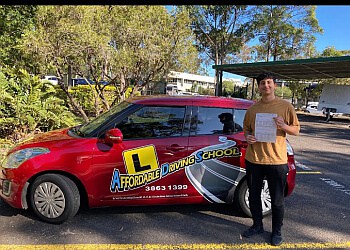A Complete Guide for Parents to Steer Their Teens to Success in Brisbane!
G’day, amazing Brisbane parents! ? Is it time for your teen to learn the art of driving? Well, buckle up, because you’re about to embark on a thrilling journey with your young one as they navigate the road to driving success. In this comprehensive guide, we’ll cover everything you need to know about driving lessons in Brisbane, ensuring your teen becomes a confident and responsible driver. Let’s get those wheels rolling!
Finding the Perfect Driving School in Brisbane
First things first, let’s talk driving schools. Brisbane is home to a multitude of driving schools, each with its own unique approach to teaching. It’s crucial to find one that aligns with your teen’s learning style and your own peace of mind. Here’s what to look for:
- Professional Accreditation: Ensure the driving school has all the necessary certifications and follows the Queensland Government’s regulations. A school with a great reputation will proudly flaunt its credentials.
- Qualified Instructors: The heart of any driving school is its instructors. Look for schools with experienced and patient instructors who have a knack for teaching young drivers.
- Friendly Learning Environment: The best learning happens in a positive environment. A patient and understanding instructor makes all the difference in helping your teen feel comfortable behind the wheel.
- Flexibility: Choose a driving school that offers flexible lesson times. Your busy bee’s schedule might be packed with school and extracurricular activities, so flexibility is key!
- Modern Fleet: A driving school that invests in modern and safe vehicles demonstrates their commitment to providing a quality learning experience.
Getting to Know the Queensland Road Rules
Before your teen takes the wheel, it’s critical to have a good grip on the road rules of Queensland. From the basics like traffic signals to the specifics of Brisbane roads, understanding these rules is a must for any new driver. Encourage your teen to study the Queensland Road Users’ Handbook, and consider quizzing them to cement their knowledge. It’s not just about passing the test – it’s about keeping them safe on the road.
The Practical Side: Learning to Drive
Once the groundwork is laid, getting practical driving experience is key. Here are some tips to ensure that practice is as effective as it is enjoyable:
- Start Slow: Begin in a secure, low-traffic area such as an empty parking lot to build confidence and get a feel for the car’s controls.
- Gradual Progression: As your teen’s confidence builds, slowly introduce them to more complex driving situations, like quiet suburban streets, before tackling high-traffic roads.
- Weather Wise: Brisbane’s weather can be unpredictable, so ensure your teen has experience driving in different conditions – be it a sunny day or a sudden downpour.
Being a parent is all about guiding your child through life’s milestones, and learning to drive is a big one. With the right preparation, knowledge, and a dash of patience, you’ll help your teen master the roads of Brisbane with confidence and safety.
Remember, this journey is not just about passing a test; it’s about nurturing a responsible driver who respects the rules and values safety above all. Let’s make this learning experience as smooth as possible, with a few laughs along the way, and pave the road to a lifetime of safe driving for your blossoming young motorist! ??

5 Essential Things Parents Should Know When Preparing for Driving Lessons in Brisbane
Welcome aboard, caring parents! Preparing your teen for their driving lessons in Brisbane is a venture filled with anticipation and responsibility. Let’s ensure your junior driver is primed and ready for the road with these five crucial pointers:
1. Understand the Graduated Licensing System
Queensland operates under a Graduated Licensing System (GLS) designed to give new drivers the chance to safely gain driving experience before obtaining a full licence. Familiarise yourself with each stage, from the Learner Licence to the Provisional Licence, including the rules and restrictions for each phase. The more you know, the better you can support your teen’s journey.
2. It’s More Than Just Driving
Driving isn’t solely about steering a car—it’s about being street smart, too. Discuss with your teen the importance of road awareness, the implications of road rage, and the significance of being an attentive and courteous driver. These conversations lay the foundation for a conscientious attitude on the road.
3. Establish Clear Guidelines
Be clear about expectations and boundaries. Set rules around when and where your teen can drive, and enforce these with love. It’s paramount that they understand the gravity of operating a vehicle and the trust you’re instilling in them.
4. Practice is Key – Be Patient
Hours of practice are needed to fulfill the logbook requirements, and even more so for skill refinement. Patiently support your teen through their mistakes and triumphs. With each session, they are one step closer to becoming a safe driver.
5. Embrace Technology and Resources
Make use of available technology such as driving simulators and educational apps to complement on-road learning. Moreover, resources like Keys2drive, an Australian Government-funded program, offers a free driving lesson to eligible learner drivers.
Armed with these insights, the journey to becoming a capable driver is all the more achievable. Take heart in knowing that with each practice session and each kilometer driven, your teen is becoming a more skilled and confident driver on Brisbane’s bustling roads. Let’s together foster a generation of responsible and safety-conscious drivers!
For more great fun click here. For more information see here
Disclaimer
The articles available via our website provide general information only and we strongly urge readers to exercise caution and conduct their own thorough research and fact-checking. The information presented should not be taken as absolute truth, and, to the maximum extent permitted by law, we will not be held liable for any inaccuracies or errors in the content. It is essential for individuals to independently verify and validate the information before making any decisions or taking any actions based on the articles.




